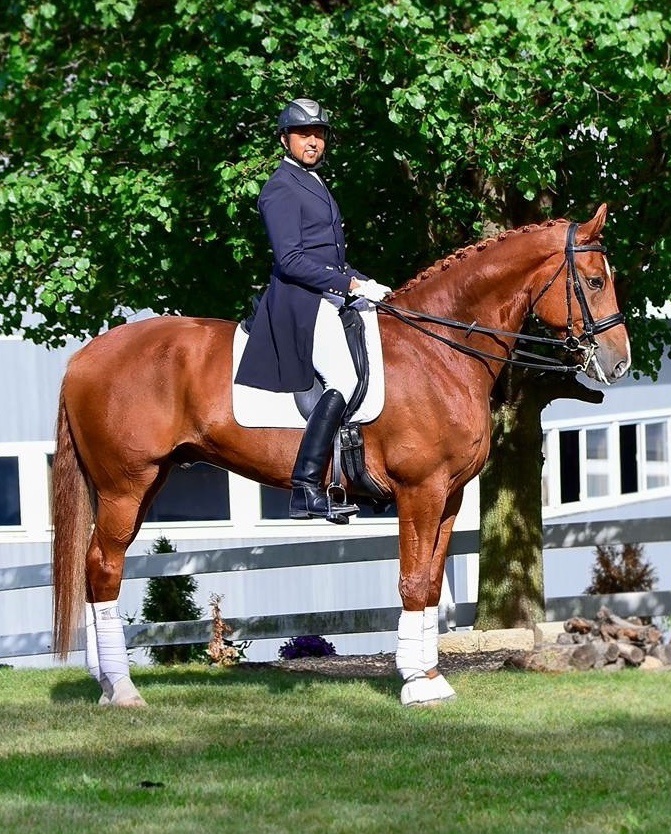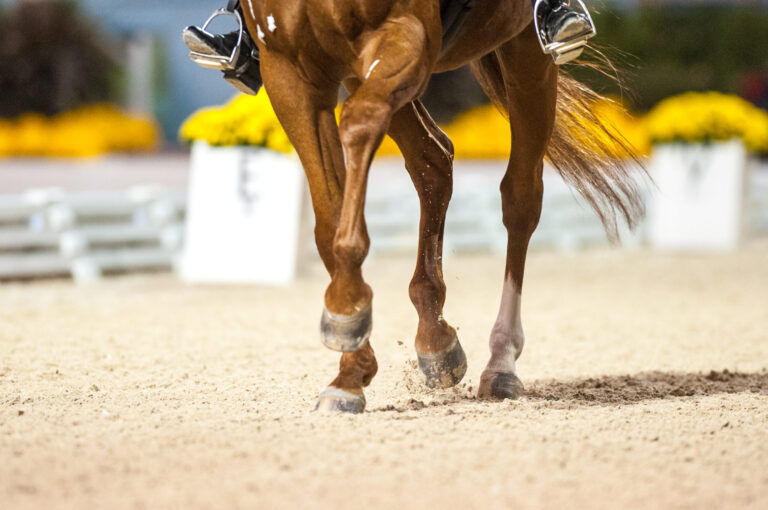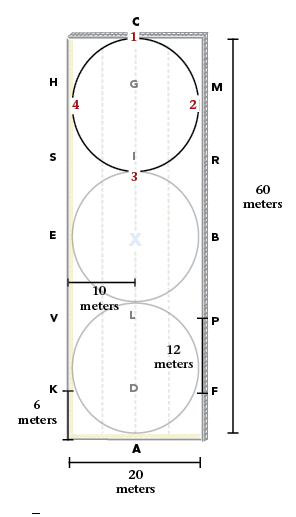When you walk into the girth section of a tack store, it’s easy to get overwhelmed by the abundance of shapes, styles and sizes offered. A girth is no longer just a means to keep the saddle on the horse. New insights into equine ergonomics have produced girths that are anatomically shaped and designed to improve comfort and performance. Which one is right for you depends on your horse’s conformation and your personal taste. Before you shop for a girth, be sure that your saddle fits correctly, as good girthing starts with proper saddle fit.

As an Amazon Associate, Dressage Today may earn an affiliate commission when you buy through links on our site. Products links are selected by Dressage Today editors.
Types of Girths: Short or Long?
Depending on the billet length of your saddle, you’ll need a short or long girth. Short girths are designed for saddles with long billets. Most dressage riders prefer a short girth because it keeps the area underneath the thighs and/or knees bulk-free. The downside is that the buckles are located farther down, directly on the horse’s body. For this reason, when using a short girth, select one with adequate padding underneath the buckle area to prevent bruising.

Long girths provide the best stability even though they are considered old-fashioned by the dressage community. They have the disadvantage of creating bulk under your legs, especially if they aren’t the correct length. To avoid this problem, the buckles should not be farther up than two to three holes from the bottom of the billets on both sides when the girth is tightened. Some top dressage riders, such as WEG competitor Catherine Haddad Staller or Olympian Ingrid Klimke are still being spotted using mostly long girths.
For a short dressage girth: The length of the girth must take into account the horse’s individual anatomy. The buckle section must sit higher than the horse’s elbow level to avoid interference during movement. Even if you are using a short girth, always use the longest girth possible. This is because the farther the girth is from the saddle tree, the less stable the connection with the tree. The ends of the girth should be close to the saddle pad without interference. As a rule of thumb, you should be able to fit about two fingers between the bottom of the saddle pad and the top of the girth.
For a long girth: The girth should sit below the crook of the rider’s knee, about two to three holes from the end of the billet, depending on the length of the leg. Although long girths provide more stability, if the girth is too long and the buckles too high on the billets, it diminishes the stability and interferes with a relaxed dressage leg. To get an estimate of the correct size, put your saddle on the horse using your old girth. Measure the distance between the middle billet holes. The number of inches you get on the measuring tape is the size you need.

Shaped or Straight?
Ergonomically shaped girths are clearly dominating the market. Two key features are cutouts to provide maximum room for the horse’s elbows and shoulders, which also prevents wrinkles, bunching up and rubbing, as well as a wider center, which helps to distribute the pressure in the area of the breastbone better.
Anatomically shaped girths work well for horses with a well-defined girth area, which gives enough room behind the elbows. These girths have cutouts for the elbows on both long sides.
Asymmetrical girths work well for horses who have a less-defined girthing area that is closer to the elbows, causing the girth to sit farther forward. These girths have a more pronounced cutout for the elbow, but only on one of the long sides of the girth.
Crescent- or moon-shaped girths are designed for horses with short backs, wide rib cages and narrow chests, where the saddle tends to slide forward. These girths are designed to take up the rounder shape of the rib cage, preventing the girth from moving forward and colliding with the elbows.
Straight girths have been around for centuries and come in a variety of materials. If your horse has a well-defined girthing and easy-to-fit saddle area, a good-quality straight girth might be all you need.
Natural or Synthetic?
Leather is a time-tested material for girths and if well-cared for, outlasts most other materials. It is breathable and usually tolerated well by horses with more sensitive skin. Most leather girths are stuffed with padding to increase comfort. The downside of leather is that you need to regularly clean and condition it to keep it smooth and prevent it from chafing.
New on the market are leather girths that are vegetable-tanned. While conventional leather-tanning techniques use chromium salts or formaldehydes, which are considered harmful to humans and the environment, vegetable tanning is an old-world process that uses tannic acids naturally found in some plant species and is considered 100 percent biodegradable and nontoxic.
Neoprene is a popular material as it is extremely soft and flexible. The advantage of neoprene is that it is extremely low maintenance. It dries quickly and is easy to wash. Some girths can even be thrown in the washer. On the downside, like many synthetic materials, neoprene can retain heat, causing skin irritations or rubs. Neoprene girths with pinholes create better airflow.

String or cord girths have been around for decades and have become a classic. Simple as they are, they offer no padding, which can be a problem when using a short girth for a long-billeted saddle, as the buckles are in direct contact with the horse’s body and can cause bruising. String girths provide good airflow and move with the horse’s body. They come in natural and synthetic materials. They are easy to care for and inexpensive. Some top dressage riders still prefer to ride with these simple girths.
Nonslip girths feature a grippy surface usually made of rubber or neoprene. These girths are a great option if you have a horse who is challenging to fit with a saddle because he has a wider, rounder barrel and flat withers, such as many pony breeds. The grippy material is designed to stabilize the panels, providing a more secure fit.
Fleece-covered girths are good at wicking away moisture and supposedly keep the skin drier and cool. Fleece comes in natural cotton or synthetic materials and some girths have a combination of the two. Cotton fleece breathes well, and synthetic lining can help wick away sweat and keep the horse dry and comfortable. Fleece girths do have the tendency to allow saddles to move around, especially if not fit properly.
Sheepskin is a popular padding material. Girth covers are usually made from real or synthetic sheepskin. Natural sheepskin regulates temperature, wicks away moisture and is well tolerated by sensitive skin. The downside is that it can only be washed in the delicate cycle (read more on p. 68). Sheepskin covers can twist and cause pressure points and skin sores. Combined sheepskin girths can prevent this problem. Horses with extremely sensitive skin will sometimes react to synthetic sheepskin when they sweat.
More Helpful Hints
Apart from style and material, there are several other aspects to keep in mind when shopping for a girth.
Width: The broader the girth, the better. Most modern short girths have a bigger footprint and give you more square inches of contact than older designs. Girths with a wider bearing surface increase the comfort level of the horse because they distribute pressure over a wider surface area.
Padding: There are different padding materials for girths, gel padding and memory foam being the most popular. Both are designed to adapt extremely well to the horse’s body and reduce pressure points. When using a short girth, look for one with generous padding around the buckle area to prevent pressure points on the skin. If it feels cushy to you, your horse is likely to agree.
Elastics: Some girths come with elasticized center panels, which distribute pressure more widely through the girth area, allowing the rib cage to expand and contract for more comfort and better breathing, and keep the saddle centered and secure. Girths with elastic straps on both sides have a similar effect. Girths that are elastic on one side act asymmetrically and pull the saddle to one side.
Buckles: Choose roller buckles, which most modern girths have, so the leather billets can travel easily when the girth is adjusted. They also prevent the girth from getting skewed to one side or the other.
Poor condition: Avoid girths that have lost their shape, and cause uneven pressure. This can be caused by age or poor design, such as stitches that run parallel to the long sides of the girth or girths with padded, parallel center panels.
Cleanliness: Since girths tend to be extremely close to the horse’s skin, make sure to keep your girth clean. Bacteria thrive on sweat and filth.
How Tight Is Tight Enough?
Once you have found the right girth, make sure you tighten it correctly. Tighten the girth gradually with feel. Listen to your horse. Tighten one set of holes at a time, very slowly working your way up until it is tight enough. You may tighten the girth on both sides alternately or on one side only. The key is that when the girth is adjusted correctly, it should sit symmetrically in the center, with the buckles on each side at about the same height. Once you know how a girth works on your horse, you’ll know what number hole to start on on the off side, and then tighten on the mounting side to achieve symmetry.
If the girth is adjusted correctly, you should be able to slide your flat hand underneath it on the left or right side. There should be a positive response to the body, like a polite handshake as opposed to someone crushing your fingers.
Never crank up the girth abruptly or adjust it as tightly as possible. Imagine tightening a belt around your body too vigorously, and see what it does to your level of comfort and breathing.
Forget the old rule of thumb that the girth should sit one hand-width behind the elbow. Each horse has a different conformation and the correct position depends on the horse’s individual anatomy and saddle fit.

When Girthiness Is Confused With Orthopedic Problems
A range of serious medical problems can manifest as girthing problems, but in reality have other causes. A. Kent Allen, DVM, who owns Virginia Equine Imaging in Middleburg, Virginia, says the two most common ones are ulcers and back pain. “In terms of back pain, it’s especially kissing spines and osteoarthritis of the dorsal articular processes. The vast majority of these problems are diagnosed as saddle-fit problems,” Dr. Allen explains. “And to be fair, there are saddle-fit problems. But conversely, there is a huge amount of undiagnosed problems that have to do with orthopedic issues in the back. Both of those will cause back pain and both of them will commonly exhibit as a horse who has a girthing problem, is cold-backed or girthy. For example, as you tighten the girth, the horse nips, objects and gets rigid in his back. Often the rider has to tighten the girth again later.”
The only way to get a definite diagnosis for an ulcer is to get the horse scoped. “Some people try a treatment trial of Gastroguard, but this way you never really know if you got the real answer,” Dr. Allen says.
To diagnose ostheoarthritis and kissing spines, the veterinarian needs to x-ray the back. To look at the dorsal processes takes a greater effort, as one needs a big, ceiling-mounted machine or a nuclear body scan, which can only be done in an equine hospital setting. Ultrasound might be another option, but takes some specific training, and not every veterinarian is able to perform it.
Dr. Allen adds that a poorly fitted or too-tight girth can also bruise the horse’s sternum. “You can have swelling in the sternum area from a too- tight girth,” he explains. “But it is less common.”
When Girthing Causes Behavioral Problems
If you routinely overtighten the girth or crank it up without feel, most horses will react by tensing the rib cage. Often, these horses seem to lose air, like a balloon, after riding for a few minutes, and you have to tighten the girth again after the horse has released some of the initial tension. This is a warning sign for your habits, or for your saddle fit. Other warning signs can include sensitivity in the elbow and breastbone area (where the girth pressure is highest), unwillingness to go forward or pinning back ears, swishing the tail, biting or kicking when the girth is tightened.
A too-tight girth can also cause damage to your saddle. You can actually deform your saddle tree with too much pressure. To get an idea just how flexible a saddle tree is, put a pad on the ground and the saddle on its pommel with the cantle facing your knees. Press the cantle on its right, then left side to see how much motion a saddle can have.
A well-fitting girth can help make a difference in your horse’s performance. While there is not one girth for every horse, ergonomically-shaped girths can provide more freedom of movement, but traditional straight girths can work just as well, especially if your horse has a defined girthing area. A smooth finish and appropriate padding around the buckles on short girths are a must, as is the right size. Remember to develop good tightening practices and never crank up your girth. If your horse is girthy, consider getting a proper veterinary exam to make sure it’s not a more serious problem. Last but not least, keep your girth clean. If you follow these principles, you might find your new girth is just what you needed to improve your competitive edge.
Cordia Pearson is a Society of Master Saddlers qualified saddle fitter. Dedicated to horse and rider, she brings years of experience to her craft. A lifelong dressage rider and Morgan breeder, she and her husband’s, Charles, foal is Avatar’s Jazzman, a U.S. Grand Prix Pony Champion. Based in Stacy, Minnesota, she saddles horses all over the world and will happily answer questions from her site saddlefitter.com.
A. Kent Allen, DVM, graduated from the University of Missouri in 1979 and has been practicing equine medicine ever since. He opened Virginia Equine Imaging in Middleburg, Virginia, in 1996, after selling his previous practice in Arizona (Arizona Equine Medical and Surgical Center). Virginia Equine Imaging became the first privately owned and operated equine diagnostic imaging specialty clinic in the world. During his transition from Arizona to Virginia, Dr. Allen served as the head veterinary services coordinator at the 1996 Olympic Games in Atlanta, and was named Arizona Equine Practitioner of the Year. Since moving to Virginia and establishing VEI, he has served as chairman of the USEF Veterinary Committee, the USEF Drug and Medication Committee, and the Medication Sub Committee for the Federation Equestre Internationale (FEI). He served as the FEI Foreign Veterinary Delegate for the 1999 Pan American Games in Winnipeg, Canada, the 2000 Olympic Games at Sydney, Australia, and the 2012 Olympic Games in London. He was also the 2010 World Equestrian Games Official Veterinary Coordinator. He is currently certified by the International Society of Equine Locomotor Pathology (ISELP), serving as its vice president and executive director. He also serves as the volunteer chairman of the USEF Veterinary, Drug, and Medications Committees and is on the FEI Veterinary and List Committees.











